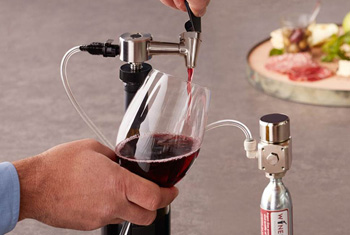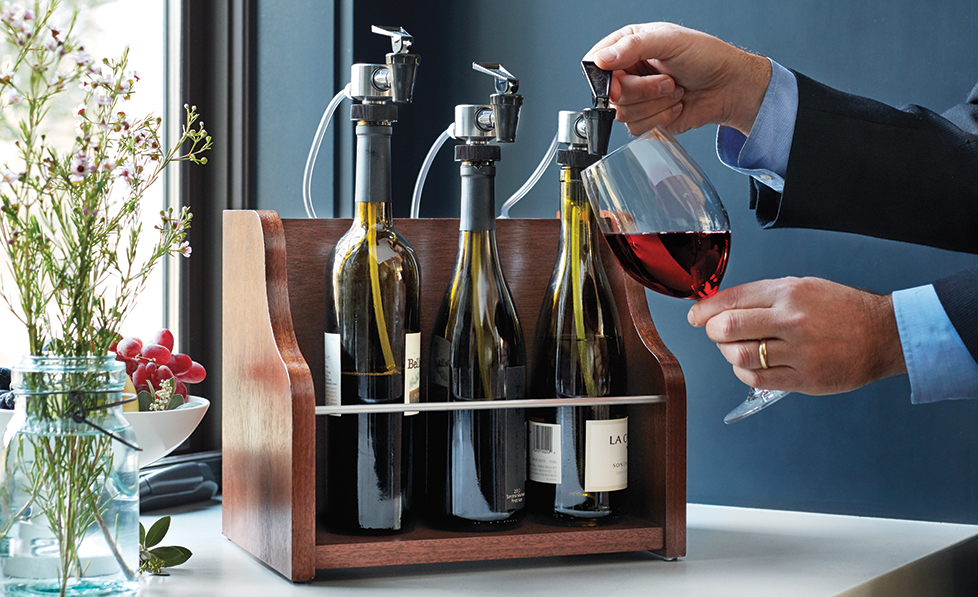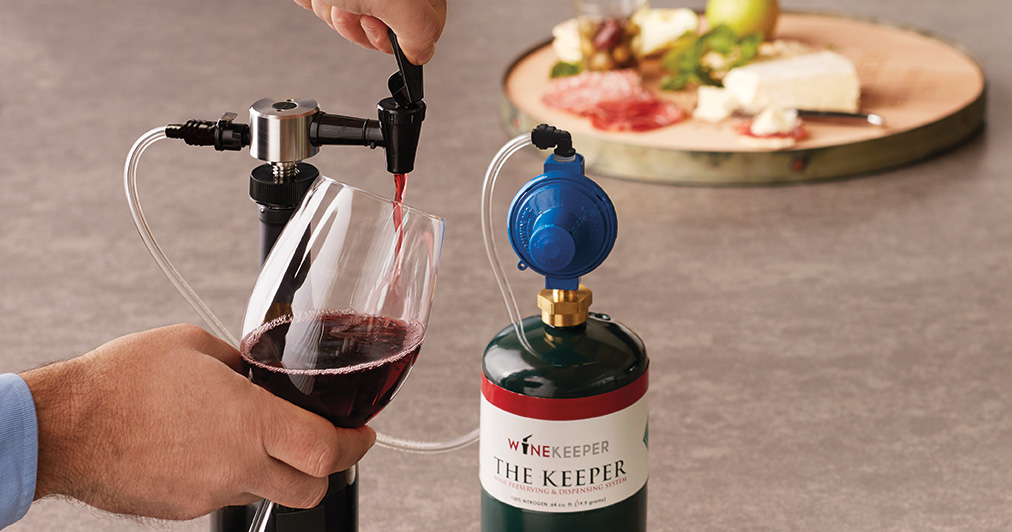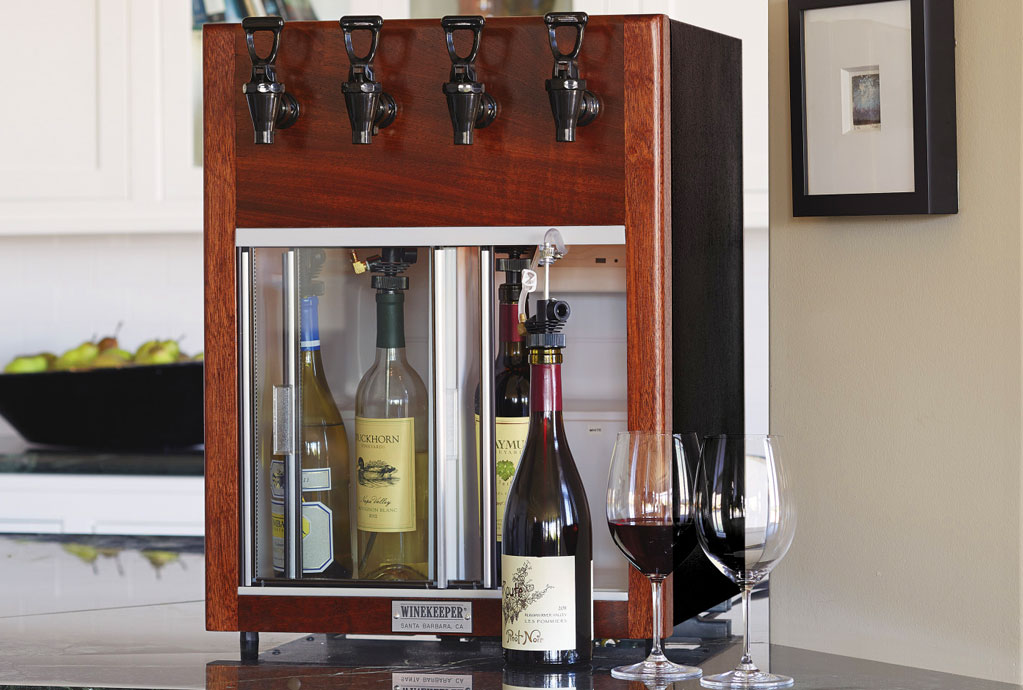
While you look forward to uncorking a rare bottle of wine you’ve saved for a special occasion, what do you do when you can’t drink more than half that bottle, knowing the wine won’t keep once exposed to oxygen?
Fortunately, you have numerous storage solutions to preserve wine after opening. While methods such as Private Preserve or the Menu Breather Decanter can buy you a few extra days, these aren’t viable long-term storage solutions.
Wine dispensers such as WineKeeper promise to increase the longevity of your wine and preserve its quality for up to two weeks. For wine collectors and restaurateurs, this sounds tempting. But if you’re wondering whether you should purchase a wine dispenser, first consider your wine collection, the cost and how much space you have available.

Why is long-term wine storage so difficult?
Wine is temperamental and can turn at the drop of a hat. High temperatures can cause premature aging and the loss of flavor and balance, while low temperatures can stunt growth and development. This is why proper wine storage is integral to preserving the quality and flavors of your wines.
Humidity also plays a factor in proper wine storage. Too much humidity can ruin the label, which is detrimental to restaurant resale. If your wine storage area is too dry, the corks can crack letting oxygen (one of the biggest contributors to wine spoilage) into the bottle.
In small doses, oxygen is an important part of a wine’s natural aging process. However, when a wine is exposed to oxygen, its properties can quickly change for the worst. Oxygen interacts with the phenols and ethanol in wine, warping its aroma, flavor and color. Ethanol oxidation is associated with acetaldehyde production. Acetaldehyde is a product of yeast fermentation; too much acetaldehyde can lead to the presence of film forming bacterias, such as acetic acid bacteria. Acetic acid is responsible for a wine’s green apple flavor, which becomes more present and overwhelming as the wine oxidizes. This is why your uncorked bottle may end up undrinkable the next day.
The benefits of a wine dispenser system

Wine storage systems protect your fine wines from oxidation using pressurized nitrogen or argon.
Nitrogen and argon are inert gases, meaning they have no color, scent or taste to interfere with the wine’s profile. When nitrogen is pumped into a bottle, it displaces the oxygenated air and fills up the extra space. Argon, which is heavier than air, provides an additional benefit by forming a blanket that rests on top — and protects — the wine.
The bottles are then sealed, trapping the inert gases and preventing more oxygen from entering the bottle and ruining the wine. Each time you dispense wine from the bottles, more argon or nitrogen is pumped in to prevent oxygen from getting in and turning the wine. In other words, dispensers pushe harmless gas into the wine bottle so oxygen can’t get in and ruin your bottle of La Mouline.
Additionally, some of wine dispensers are temperature-regulated to keep your wine at perfect serving temperatures.
The wines best suited for longer-term preservation
Which wines should you store in your new WineKeeper?
It depends on the model you choose. Many options have a dual-temperature gauge for storing both whites and reds. Only red wines should be stored in the Showcase and Tasting Stations, as these models do not come with temperature regulators.
As a general rule, medium-to-high priced wines that oxidize quickly should be stored in dispensers to preserve their aroma and flavor. Many older reds do well in the WineKeeper as they have already completed their aging process and respond well to the lack of external oxygen. White wines also tend to do well in these storage conditions.
Avoid storing Champagne and other bubbles. These wines require carbon dioxide, rather than nitrogen or argon, to preserve their effervescence.

Is it time to buy a WineKeeper?
Consider your wine collection and needs with these questions:
1. What type of wine drinker are you?
If you’re an occasional wine drinker who doesn’t collect wine, it’s unlikely you’ll need a wine saver. You’ll be much happier using a vacuum sealer to keep an open bottle fresh for a few days.
If you collect expensive, rare wines, you may want to consider adding the WineKeeper as an accessory to your wine cellar — especially if you like to enjoy your bottles over the course of a few days instead of all at once.
Restaurateurs with by-the-glass menus can offer high-quality wines without worrying about high spoilage costs if the wine doesn’t get consumed the day it’s opened.
2. How much space do you have for a wine dispenser?
You should also consider your available space before buying a dispenser. While several customizable options are available in terms of size, the standard version will need room for proper ventilation; Verify you can leave three inches of space on each side, one inch of space behind and 12 inches of space above.
Also keep in mind you can store a limited number of bottles in the WineKeeper. While the Tasting Station can preserve up to 20 bottles, restaurants will still need to find proper storage for additional uncorked bottles, as well as their remaining unopened stock.
3. What’s your budget for a wine dispenser?
Cost should also be taken into consideration. A refrigerated storage model can range from $1,800-$8,000, not including installation and maintenance costs. These models would be best for a restaurateur or a serious wine collector, as the preservation of their collections justify the costs. Restaurateurs will ultimately save money by reducing waste.
For a gift or for a new collector, less expensive options such as The Keeper are designed to preserve a single bottle.
Proper storage comes first
For the discerning wine collector and restaurateur, the WineKeeper is an excellent way to preserve beautiful bottles of wine, allowing you to enjoy a glass whenever you’d like without fear of compromising the wine. Provided you have the space, the WineKeeper’s customizable facade allows it to blend seamlessly with your decor and ensures the size and storage capacity suits your needs.
If you care about your wine collection, this accessory is for you. Yet it’s important to note a wine dispenser is just that: an accessory. The WineKeeper provides an additional wine saving option and is not intended to take the place of a wine cellar or other means of proper wine storage. Keep in mind that the best way to prevent spoilage and truly enjoy your collection is through proper storage.
About the author: Ariel Berchtold is a freelance writer with a passion for wine, food and travel. She backpacked the world with her husband in 2014 and blogged about all of their wonderful travels.
Exceptional Article! I think the best-described article for wine preservation. It is step by step so I get all answers to my questions and is very informative at the same time.
– Roberto Rinaldini